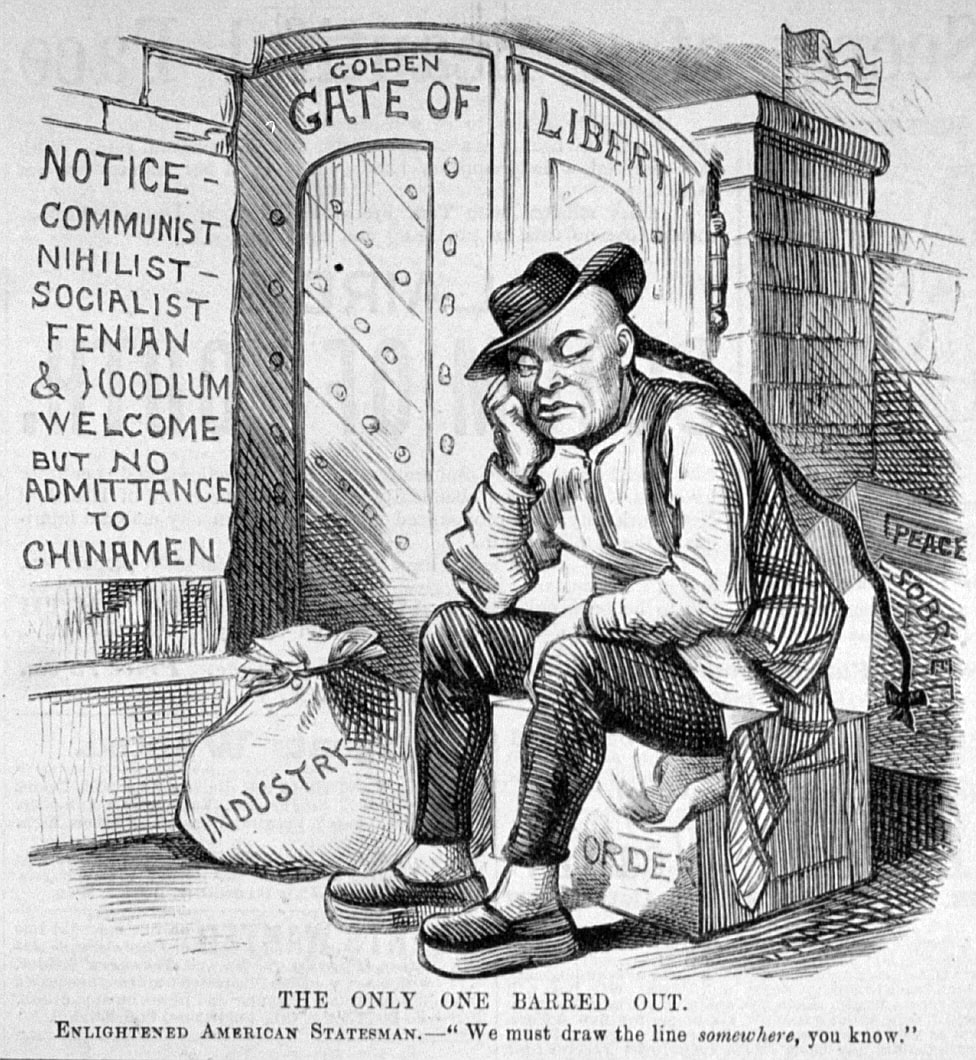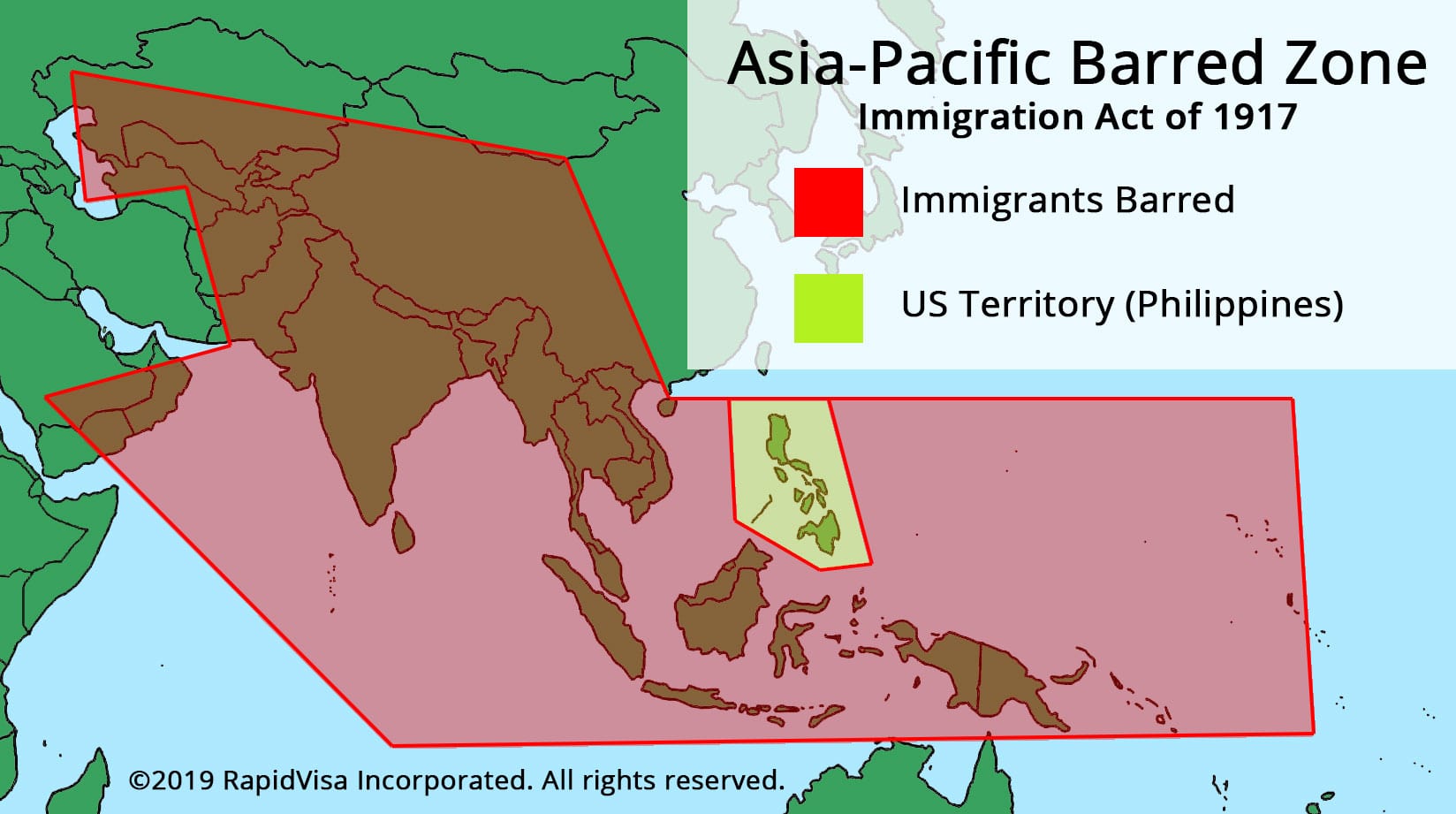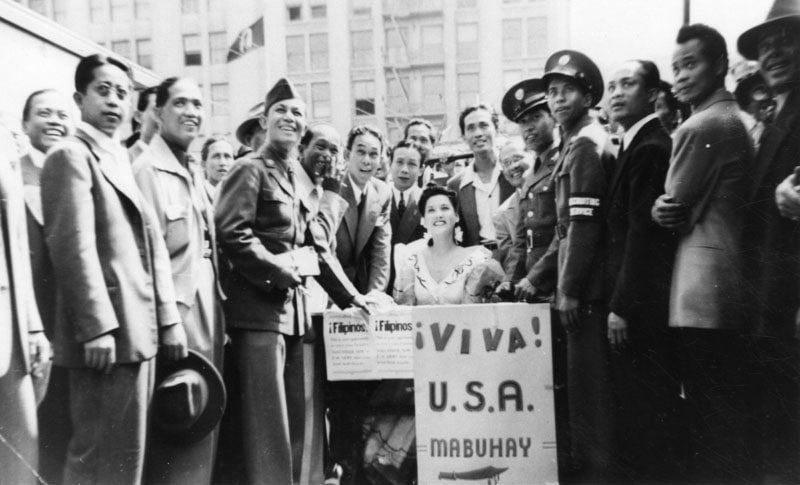We have compiled a list of notable U.S. immigration laws in chronological order from the dates they were enacted. Over the years, certain provisions of old laws are replaced with more recent laws. This list is not comprehensive, and does not include proposed legislation that was not signed into law, such as the DREAM Act, nor does it include Presidential Executive Orders, such as DACA, which are not laws. This compendium is for research and informational purposes as a free resource to the public. We just ask that if you use this resource, please link back to this page as a source for your research.
Year |
Legislation |
President |
Key Provisions |
|---|---|---|---|
1790 |
Naturalization Act of 1790 |
George Washington
|
Establishes rules to become a citizen, exclusive to free white persons of "good character" who have resided in the country for at least two years. Excludes Native Americans, indentured servants, and black slaves. |
1795 |
Naturalization Act of 1795 | Increased residence period for naturalization eligibility from two to five years. | |
1798 |
Naturalization Act of 1798 |
John Adams
|
Increased residence period for naturalization eligibility from five to fourteen years. |
| Alien Friends Act (Alien and Sedition Acts) |
Allowed the President to deport aliens he felt were "dangerous to the peace and safety of the United States". | ||
| Alien Enemies Act (Alien and Sedition Acts) |
Allowed the President to deport any male citizen of a hostile nation above the age of fourteen during times of war. | ||
1802 |
Naturalization Law of 1802 | Thomas Jefferson | Decreased residence period for naturalization eligibility from fourteen to five years. Granted children born abroad to U.S. citizen parents citizenship. |
1864 |
Immigration Act of 1864 (An Act to Encourage Immigration) |
Abraham Lincoln | Created a new office and position for a "Commissioner of Immigration" to oversee immigration matters in an effort to increase immigration. |
1870 |
Naturalization Act of 1870 | Ulysses S. Grant | Extends citizenship eligibility to former slaves ("aliens of African nativity and to persons of African descent"). Makes immigration fraud illegal. |
1875 |
Page Act of 1875 (Oriental Exclusion Act of 1875) |
Effectively banned entry of most Asian women, especially Chinese women out of fear of increasing prostitution. | |
1882 |
Chinese Exclusion Act |
Chester A. Arthur |
Expanded the Page Act's efforts by extending the ban to Chinese males, including laborers. |
| Immigration Act of 1882 | Established fees for incoming immigrants, called a "head tax" in the amount of $0.50. Restricted criminals and invalids from immigrating. | ||
1885 |
Alien Contract Labor Law (Foran Act) |
Restricted "importation" and migration of alien contract workers, or indentured servants. Allowed for deportation of prohibited migrants. | |
1888 |
The Scott Act | Grover Cleveland | Expanded on the Chinese Exclusion Act by banning Chinese residents from re-entering the US at the borders and ports. If they left, they could never return. |
1891 |
Immigration Act of 1891 | Benjamin Harrison | Expanded excludable aliens to public charges, people with contagious diseases, polygamists and criminals. Established border procedures, including requiring vessels arriving by sea to provide a list of passengers for immigration inspectors at the port. Incoming immigrants to be subject to medical examination. Grants authority to deport certain aliens. Opening of Ellis Island. Established the most comprehensive rules and enforcement mechanisms to this point. |
1892 |
Geary Act | Further expanded the teeth of the Chinese Exclusion Act by adding more punitive requirements. All Chinese residents were required to carry a resident permit, and could be deported if they were caught without it. | |
1903 |
Immigration Act of 1903 (Anarchist Exclusion Act) |
Theodore Roosevelt | Prohibited immigration by anarchists, epileptics, beggars and pimps. |
1906 |
Naturalization Act of 1906 | Required immigrants to speak English to become naturalized citizens. Established the "Bureau of Immigration and Naturalization", a predecessor to the USCIS. | |
1907 |
Immigration Act of 1907 | Increased groups of excludable aliens to include:
"All idiots, imbeciles, feebleminded persons, epileptics, insane persons, and persons who have been insane within five years previous; persons who have had two or more attacks of insanity at any time previously; paupers; persons likely to become a public charge; professional beggars; persons afflicted with tuberculosis or with a loathsome or dangerous contagious disease; persons not comprehended within any of the foregoing excluded classes who are found to be and are certified by the examining surgeon as being mentally or physically defective, such mental or physical defect being of a nature which may affect the ability of such alien to earn a living…" |
|
1917 |
Immigration Act of 1917 (Literacy Act; Barred Zone Act) |
Woodrow Wilson |
President Wilson vetoed the bill, but Congress overrode the veto to make it law. Imposed literacy test on immigrants and barred immigrants from Asia-Pacific zone. Added yet even more excludable alien categories such as alcoholics and vagrants. |
1918 |
Immigration Act of 1918 (Dillingham-Hardwick Act) |
Enabled the government to deport certain alien activists, such as anarchists, communists, and labor organizers. | |
1921 |
Emergency Quota Act of 1921 | Warren G. Harding | In response to an influx of Jews fleeing persecution in Eastern Europe, the National Origins Formula was established, setting quotas for immigrants. The quota biased in favor of immigrants from Northern Europe. New immigrants plummeted from 805,228 in 1920 to just 309,556 in 1921. |
1922 |
The Cable Act of 1922 (Married Women’s Independent Nationality Act) |
Prior to this law, US citizen women would lose their citizenship if they married a foreigner. This act reversed the loss of citizenship to US citizen woman who married a foreigner. Oddly enough, neither of these laws applied to US citizen men who married foreign women. | |
1924 |
Immigration Act of 1924 (National Origins Quota Act; Johnson-Reed Act) |
Calvin Coolidge | Banned more immigrants from the Eastern Hemisphere, tightened quotas, and provisioned funds and enforcement mechanisms to carry out all of the prior banned immigrants. Total immigration plummeted from 357,803 to just 164,667. |
1934 |
Equal Nationality Act of 1934 | Franklin D. Roosevelt | Equalized expatriation, immigration, naturalization, and repatriation between women and men. |
1940 |
Nationality Act of 1940 |
Codified conditions for "birthright citizenship" as well as laid out rules for how aliens of certain races (white, black, and Native Americans) can become naturalized citizens. Granted US citizenship to Puerto Ricans. Granted citizenship to individuals from the Philippines who served in the US military. Provided foreign spouses and children of US citizens a path to citizenship. |
|
| Alien Registration Act (Smith Act) |
Passed during WWII, it enacted criminal penalties for aliens "...with intent to cause the overthrow or destruction of any such government, prints, publishes, edits, issues, circulates, sells, distributes, or publicly displays any written or printed matter advocating, advising, or teaching the duty, necessity, desirability, or propriety of overthrowing or destroying any government in the United States by force or violence, or attempts to do so; or...organizes or helps or attempts to organize any society, group, or assembly of persons who teach, advocate, or encourage the overthrow or destruction of any such government by force or violence; or becomes or is a member of, or affiliates with, any such society, group, or assembly of persons, knowing the purposes thereof." Required aliens to register biometrics and take an oath to not engage in such activities. |
||
1943 |
Chinese Exclusion Repeal Act of 1943 (Magnuson Act) |
Repealed the Chinese Exclusion Act, and allowed Chinese immigration for the first time since 1882, although the quota was still very low. Granted eligible Chinese immigrants a path to citizenship. | |
1945 |
War Brides Act | Harry S. Truman |
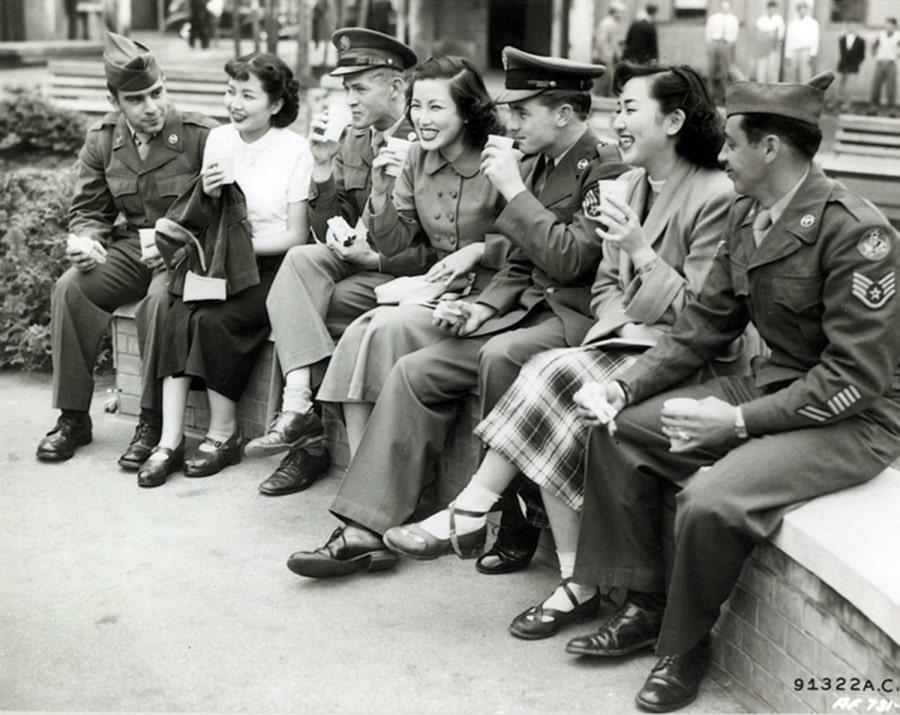 Japanese war brides - Many America soldiers returned from WWII with wives who eventually assimilated into American culture. Allowed alien spouses as well as natural and adopted children of US soldiers the ability to immigrate without the limitations of any quotas. |
1946 |
Alien Fiancées and Fiancés Act of 1946 | Expanded the non-quota immigration of the War Brides Act to fiances and fiancees. If the alien fiance(e) didn't marry after arriving, they were subject to deportation. This was exclusive to US soldiers, not all US citizens. | |
1948 |
Displaced Persons Act of 1948 | Due to the large amount of Europeans displaced after WWII, the US allowed 200,000 additional refugees to immigrate outside the quota system. | |
1952 |
Immigration and Nationality Act of 1952 (McCarran-Walter Act) |
Originally vetoed by Truman, but the veto was overridden by Congress. The last major comprehensive immigration reform that's still active, although amended by the Immigration Act of 1990 and the Patriot Act. Updated and codified immigration eligibility requirements, quotas, procedures and enforcement mechanisms. Removed racial restrictions of previous laws. Expanded the term "citizen" to include inhabitants of Guam. Favored certain skilled laborers for work-related visa quota. | |
1953 |
Refugee Relief Act of 1953 (Emergency Migration Act) |
Dwight D. Eisenhower | Following the Displaced Persons Act of 1948, Congress addressed that displaced Europeans was higher than initially thought. This law allowed admission of an additional 214,000 immigrants from Italy, Greece, Holland and other European countries who were displaced during WWII. |
1961 |
Fulbright–Hays Act of 1961 (Mutual Educational and Cultural Exchange Act) |
John F. Kennedy | Passed the same month as the Peace Corps was founded, in an effort to "...increase mutual understanding between the people of the United States and the people of other countries..." this law established educational, work and cultural exchange programs. |
1962 |
Migration and Refugee Assistance Act of 1962 | Grants the President the ability to act quickly if and when refugee crises arise around the world to designate funds and allow asylee entrants. | |
1965 |
Immigration and Nationality Act of 1965 (Hart-Celler Act) |
Lyndon B. Johnson |
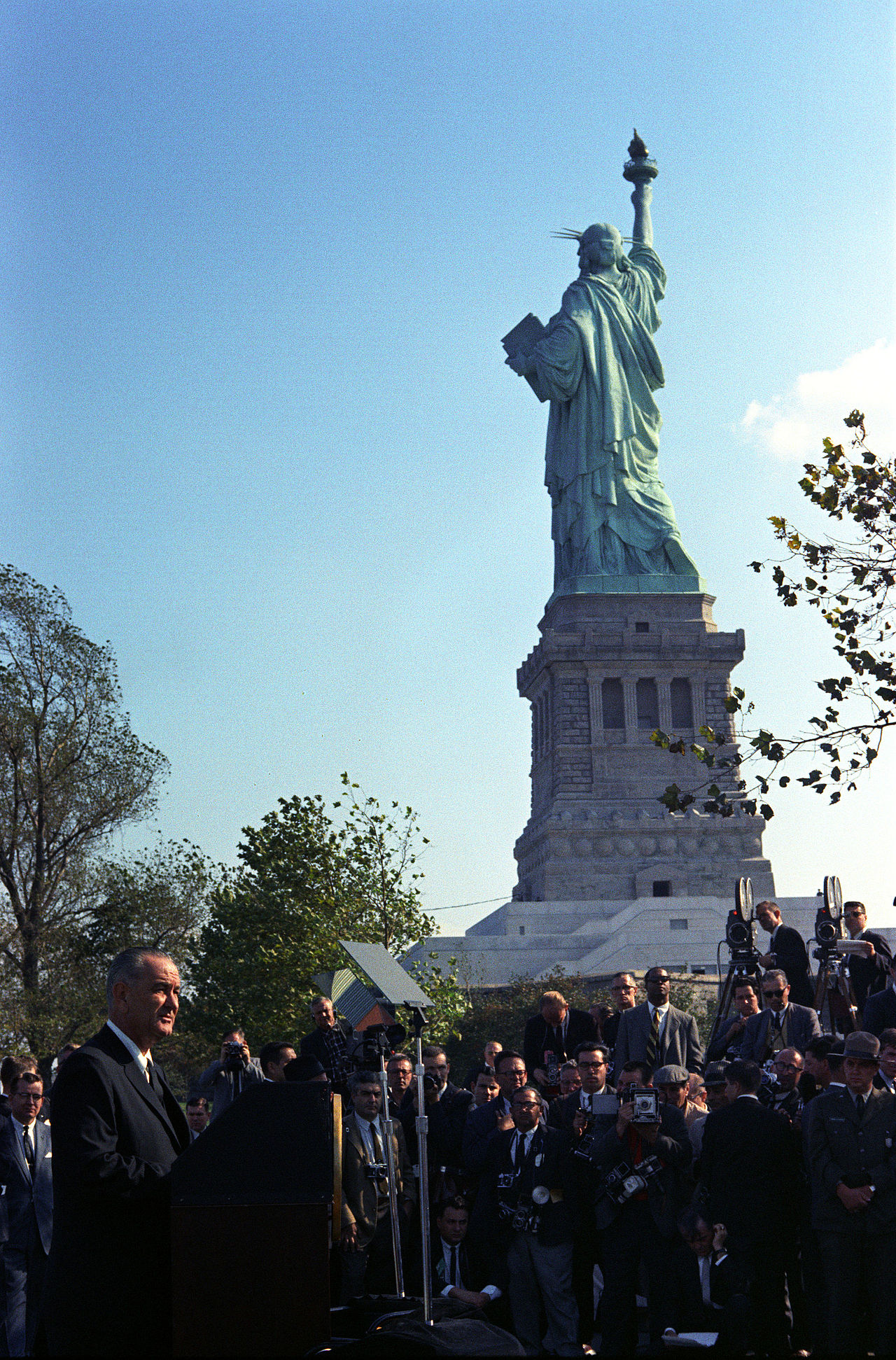 October 3, 1965: President Lyndon B. Johnson visits the Statue of Liberty to sign the Immigration and Nationality Act of 1965. Passed during the height of the Civil Rights Movement, this law abolished the National Origins Formula quota system which was heavily biased towards rich white Northern Europeans for a slightly more sensible quota system. Gave preference to relatives of US citizens and legal permanent residents as well as individuals with unique specialized work skills. Excluded immediate relatives from the quota system. Imposed a quota on Western European countries for the first time. Addressed wage requirements for the H1B, H2A, H2B, and D1 visa categories. |
1966 |
Cuban Refugee Adjustment Act | Provided path for Cubans to be admissible to the United States and become naturalized citizens. | |
1970 |
Public Law 91-225 | Richard Nixon | Established the K-1 Fiance Visa |
1975 |
Indochina Migration and Refugee Assistance Act of 1975 | Gerald Ford | Provided entry to 130,000 refugees from South Vietnam, Laos and Cambodia after the end of the Vietnam War. |
1976 |
Immigration and Nationality Act Amendments of 1976 | Adopts "preference categories" for immigrants from Western Hemisphere countries. | |
1980 |
Refugee Act of 1980 | Jimmy Carter | Provides comprehensive provisions for resettlement of refugees on humanitarian basis. |
1986 |
Immigration Reform and Control Act (Simpson–Mazzoli Act) |
Ronald Reagan |
Made it illegal to hire undocumented immigrants, while providing legal status (amnesty) for undocumented immigrants already in US. |
1988 |
Anti-Drug Abuse Act | Adds "aggravated felony" as a ground for deportation. | |
1990 |
Immigration Act of 1990 | George H. W. Bush | Established the EB investor visa category; Established the Diversity Lottery Program; Drastically increased immigration caps. |
1994 |
Violent Crime Control and Law Enforcement Act | Bill Clinton | Allows for bypassing of deportation proceedings for certain aggravated felons and increases smuggling penalties. |
1996 |
Antiterrorism and Effective Death Penalty Act | Allows for expedited removal of certain individuals who pose potential terrorist threat. | |
| Illegal Immigration Reform and Immigrant Responsibility Act of 1996 (IIRaIRA) |
Establishes expedited removal procedures, adds more crimes to "aggravated felony" list, provides for increase in border patrol funding. | ||
1997 |
Nicaraguan Adjustment and Central American Relief Act | Provided deportation relief from certain Nicaraguans, Cubans, Salvadorans, Guatemalans, nationals of former Soviet bloc countries who arrived as asylees. | |
2001 |
USA Patriot Act | George W. Bush |
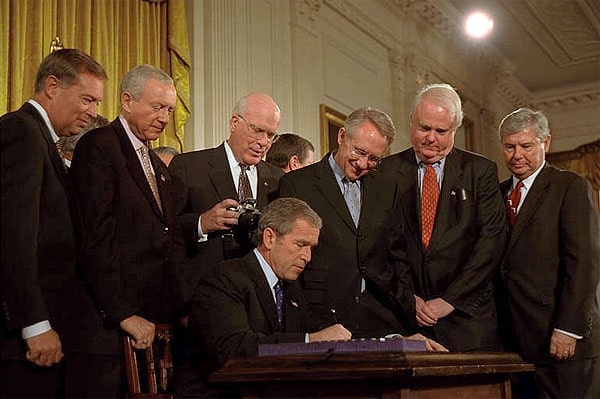 President George W. Bush signs the Patriot Act into law on October 26, 2001, less than two months after the 9/11 attacks. Increases monitoring of nonimmigrant aliens, especially students; Expands definition of "terrorist" to exclude more immigrants from entering the US. |
2002 |
Enhanced Border Security and Visa Entry Reform Act of 2002 | In the wake of the 9/11 attacks, this law was created to require sharing of alien biometric data between all INS databases. Added more regulations to the issuance of visas. | |
| Homeland Security Act of 2002 | In the wake of the 9/11 terrorist attacks, this act established the Department of Homeland Security (DHS), which abolished the Immigration and Naturalization Service (INS) which was under the Justice Department. Now, all immigration related matters were to be under their own department, DHS, taking on all former functions of the INS. The three agencies under the DHS are United States Citizenship and Immigration Service (USCIS), United States Customs and Border Protection (CBP), and United States Immigration and Customs Enforcement (ICE). | ||
2005 |
Real ID Act | Expands terrorism-related grounds for deportation and admissibility. Requires states to verify legal status of aliens obtaining drivers licenses. | |
| International Marriage Broker Regulation Act of 2005 (IMBRA) |
Requires background checks for marriage visa sponsors and sets the K1 lifetime limit to 2. If K1 applicant uses an international marriage broker, they are required to follow certain legal requirements. Requires disclosure of US sponsor's criminal background to the alien beneficiary. | ||
| Secure Fence Act | Authorizes and funds construction of 700 miles of border fencing along the US-Mexico border. Provides further border security funding and measures. | ||
2006 |
Adam Walsh Child Protection and Safety Act | Disqualified child sexual predators from being able to sponsor alien relatives and fiances. |
